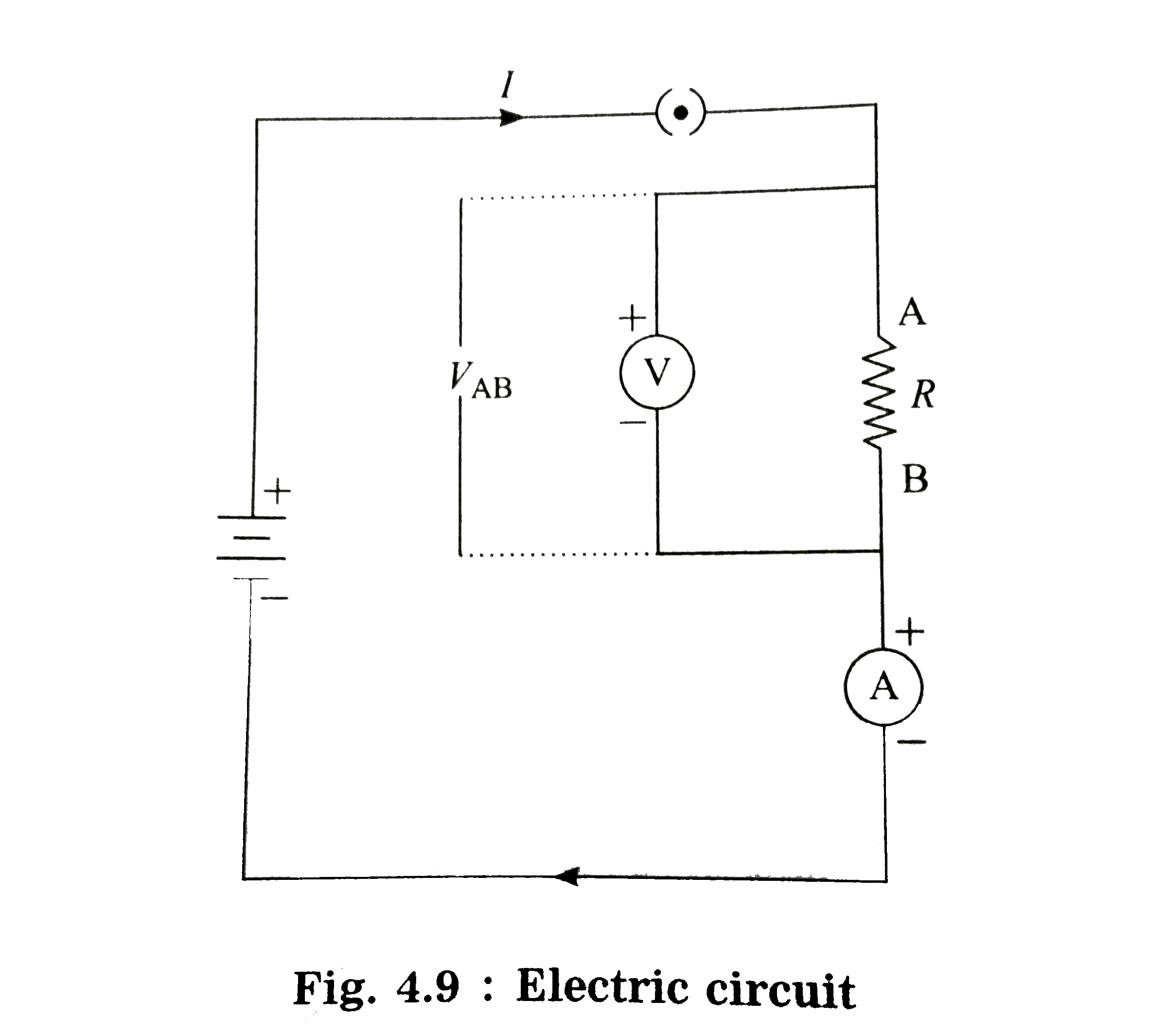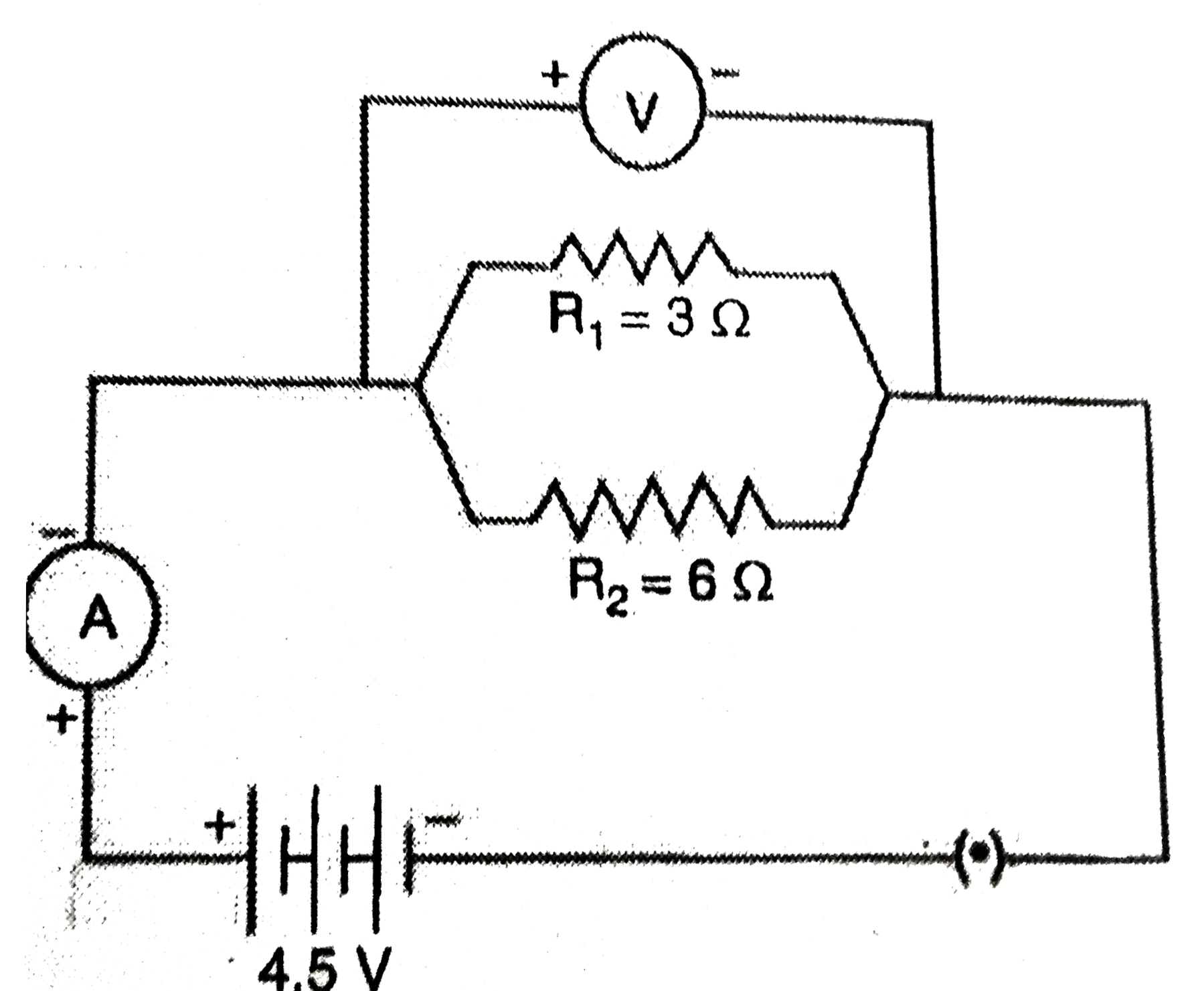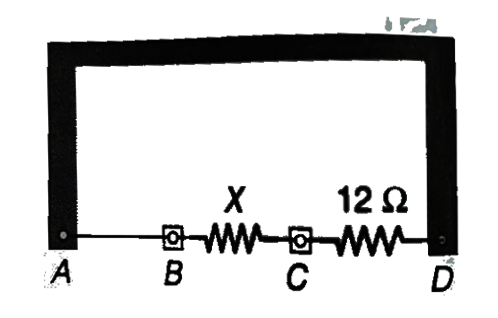Materials: connecting wires, electric cells, electrical resistance, voltmeter, ammeter, plug key.
Procedure: Connect the circuit as shown in the figure below, after taking the components with proper values.
From where does the energy come to perform work on charge Q while going from A to B?

When a charge Q flows from A to B in time t, work is performed and during that time energy Q is given to the resistor. The cell gives this energy through the charge Q to the resistance to perform the work Q.
Topper's Solved these Questions
- EFFECTS OF ELECTRIC CURRENT BOOK - TARGET PUBLICATIONCHAPTER - EFFECTS OF ELECTRIC CURRENT EXERCISE - Chapter Assesment
31 Videos
- EFFECTS OF ELECTRIC CURRENT BOOK - TARGET PUBLICATIONCHAPTER - EFFECTS OF ELECTRIC CURRENT EXERCISE - Solve the following problems
26 Videos
- EFFECTS OF ELECTRIC CURRENT BOOK - TARGET PUBLICATIONCHAPTER - EFFECTS OF ELECTRIC CURRENT EXERCISE - Practice Problems
24 Videos
- DISASTER MANAGEMENTBOOK - TARGET PUBLICATIONCHAPTER - DISASTER MANAGEMENTEXERCISE - CHAPTER ASSESSMENT
2 Videos
- ENVIRONMENTAL MANAGEMENT BOOK - TARGET PUBLICATIONCHAPTER - ENVIRONMENTAL MANAGEMENT EXERCISE - APPLY OUR KNOWLEDGE
28 Videos
Similar Questions
Material : Connecting wires , electric cells, electrical resistance, voltmeter , ammeter , plug key.
Procedure : Connect the circuit as shown in the accompanying figure after taking the components with proper values. Measure the current (I). Also measure the potential difference (V)AB between the two ends (A and B) of the resistance .
The potential at A is higher than the potential at B as the point A is connected to the positive electrode of the cell and the point B to the negative electrode of the cell.

What happens to this energy?
View SolutionConnect the circuit as shown in figure Connect a copper wire, thicker and straight as compared to the connecting wires, between A and B. Keep a magnetic needle adjacent to the wire. Keep the plug key open in the circuit and observe the direction of the needle. Close the plug key and observe the direction of the needle. What do you notice? Now interchange the connecting wires connected to the cell and observe the direction of the magnetic needle. Do you notice any relation between the direction of current and position of the needle?

What do you learn from this experiment?
View Solution
Knowledge Check
The current following through a resistor connected in an electric circuit and the potential difference applied across its ends are shown in the figures below :
The value of the resistance of the resistor is :
 A10ΩB15ΩC20ΩD25Ω
A10ΩB15ΩC20ΩD25ΩThe ammeter, voltmeter and, resistors R1 and R2 connected in the circuit as shown below have been checked and found to be correct.
On plugging the key, the voltmeter reads 4.5 V but the ammeter reads 1.5 A. This is most likely because the wires joined to :
 Aresistor R1 are looseBresistor R2 are looseCboth the resistors R1 and R2 are looseDammeter terminals are loose
Aresistor R1 are looseBresistor R2 are looseCboth the resistors R1 and R2 are looseDammeter terminals are looseA blackbox (BB) which may contain a combination of electrical circuit elements (resistor, capacitor or inductor) is connected with other external circuit elements as shown below in the figure (a). After the switch (S) is closed at time t = 0, the current (I) as a function of time (t) is shown in the figure (b).

From this we can infer that the blackbox containsAA resistor and a capacitor in seriesBA resistor and a capacitor in parallelCA resistor and an inductor in seriesDA resistor and an inductor in parallel
A rotary potentiometer has a circular resistance (C) and a conducting wiper (W) can rotate over it. An ideal battery and an ideal voltmeter are connected to it as shown in the figure. As the wiper is rotated on the circular resistance the reading of the voltmeter changes from zero to 20V. What is reading of the voltmeter when wiper is at angular position θ=120∘ ? Assume that resistance C is almost a complete circle and resistance of all connecting wires and knobs in the circuit is zero.

View SolutionA thin uniform wire AB of length 1m, an unknown resistance X and a resistance of 12Ω are connected by thick conducting strips, as shown in the figure. A battery and a galvanometer (with a sliding jockey connected to it) are also available. Connections are to be made to measure the unknown resistance X. Using the principle of Wheatstone bridge answer the following questions :
(a) Are there positive and negative terminals on the galvanometer?
(b) Copy the figure in your answer book and show the battery and the galvanometer (with jockey connect at appropriate points.
(c) After appropriate connections are made, it is found that no deflection takes place in th, from galvanometer when the sliding jockey touches the wire at a distance of 60cm from A. Obtain value of the resistance X.

View SolutionTwo metal spheres of same radius R are placed at a very large distance from each other, and they are connected by a coil of inductance L, as it is shown in the figure. One of the spheres is loaded with electric charge. At what time, after closing the switch S. does the charge on this sphere decreases to half ?

View SolutionAn electric field line emerges from a positive point charge +q at angle α to the straight line connecting it to a negative point charge −2q as shown in figure. At what angle β with the field line enter the charge−2q ?

View SolutionTwo metal spheres of same radius R are placed at a very large distance from each other, and they are connected by a coil of inductance L, as it is shown in the figure. One of the spheres is loaded with electric charge. At what time, after closing the switch S. does the charge on this sphere decreases to half ?

View Solution
